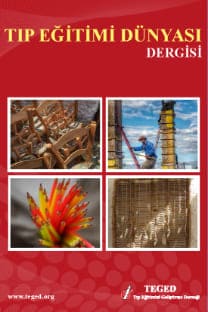EKİPLE BİRLİKTE ÖĞRENME VE OLGUYA DAYALI ÖĞRENME YÖNTEM UYGULAMALARININ KARŞILAŞTIRILMASI
Ekiple birlikte öğrenme, profesyonel beceriler, problem çözme, klinik akıl yürütme, öğrenci başarısı
Özlem Sarıkaya, Sinem Yıldız
Team-based learning, Professional skills, problem solving, clinical reasoning, exam score,
___
- ) McMahon KK. Team-Based Learning. In: An introduction to medical teaching (Eds) Jeffries WB, Huggett KN. Springer, London, New York 2010; pp.55-64.
- ) Michaelsen LK, Sweet M. Team-Based Learning. New Directions on Teaching and Learning 2011; 128: 41-51.
- ) Kelly PA, Haidet P, Schneider V, Searle N, Seidel CL & Richards BF. A comparison of in-class learner engagement across lecture, Problem-Based Learning, and team learning using the STROBE classroom observation tool. Teaching and Learning in Medicine 2010;17(2): 112–8.
- ) Lane DR. Teaching skills for facilitating Team-Based Learning. New Directions on Teaching and Learning 2008; 116: 55-68.
- ) McInerney MJ. Team-based learning enhances long-term retention and critical thinking inan undergraduate microbial physiology course. Microbiology Education Journal 2003; 4(1): 3–12.
- ) Parmelee DX, DeStephen D, Borges NJ. Medical students’ attitudes about team-based learning in a pre-clinical curriculum. Medical Education Online 2009; 14(1) (at http://www.med-edonline.org).
- ) Vasan NS, DeFouw DO, Compton S. A Survey of student perceptions of Team-Based Learning in Anatomy curriculum: Favorable views unrelated to grades. Anatomical Sciences Education 2009; 2:150–5.
- ) Thompson BM, Schneider VF, Haidet P, Levine RE, McMahon KK, Perkowski LC & BF Richards. Team-based learning at ten medical schools: two years later. Medical Education 2007; 41: 250–7.
- ) Seidel CL, Richards BF. Application of Team Learning in a medical physiology Course. Academic Medicine 2001; 76(5): 533.
- ) Conway SE, Johnson JL, and Ripley TL. Integration of Team-Based Learning strategies into a cardiovascular module. American Journal of Pharmaceutical Education 2010; 74 (2): 1-7.
- ) Goldberg HR and Dintzis R.The positive impact of team-based virtual microscopy on student learning inphysiology and histology. Adances Physiology Education 2007; 31: 261–5.
- ) Zgheib NK, Simaan JA, Sabra R. Using team-based learning to teachpharmacology to second year medicalstudents improves student performance. Medical Teacher 2010; 32: 130–5.
- ) Koles PG, Stolfi A, Borges NJ, Nelson S and Parmelee DX. The impact of Team-Based Learning on medical students’ academic performance. Academic Medicine 2010, 85(11): 1739-45.
- ) Letassy NA, Fugate SE, Medina MS, Stroup JS and Britton ML. Using Team-based Learning in an endocrine module taught across two campuses. American Journal of Pharmaceutical Education 2008; 72 (5): 1-6.
- ) Beatty SJ, Kelley KA, Metzger AH, Bellebaum KL and McAuley JW. Team-based Learning in therapeutics workshop sessions. American Journal of Pharmaceutical Education 2009; 73 (6): 1-7
- ISSN: 1303-328X
- Yayın Aralığı: Yılda 3 Sayı
- Başlangıç: 2000
- Yayıncı: Tıp Eğitimini Geliştirme Derneği
SİNEMA VE TIP TÜRK SİNEMASINDA DOKTOR VE HASTA TEMALI FİLMLER
Yeşim ŞENOL, Begüm Deniz Bulat, Esingül Kaya, Alican Abacı, Muzaffer Sindel, Ahmet Turan Aydın
EKİPLE BİRLİKTE ÖĞRENME VE OLGUYA DAYALI ÖĞRENME YÖNTEM UYGULAMALARININ KARŞILAŞTIRILMASI
MEZUNİYET ÖNCESİ TIP EĞİTİMİNDE MESLEKSEL BECERİ EĞİTİMİNE YÖNELİK E-ÖĞRENME UYGULAMASI
Erol Gürpınar, M. Kemal Alimoğlu, Esin Kulaç, Melis Nacar, Işıl İrem Budakoğlu, Nazan Karaoğlu, Nilüfer Demiral YILMAZ, Selcen ÖNCÜ, Cahit Taşkıran, Ayhan Çalışkan, İpek Gönüllü, Arif Onan, Sümer MAMAKLI
SÜLEYMAN DEMİREL ÜNİVERSİTESİ TIP FAKÜLTESİ ÖĞRETİM ÜYELERİNİN ÖĞRETİM STİLLERİ; İLK SONUÇLAR
Esin Kulaç, Erol Gürpınar, Hasan Hüseyin Uysal
Levent ALTINTAŞ, Mustafa Kemal ALİMOĞLU, Tuncay Müge ALVUR, Gürel YILDIZ, Samet DİRİ
Nazan Karaoğlu, Ayşe Hilal Batı, Yeşim Şenol, Melis Naçar, Ali Özer, Levent Altıntaş
